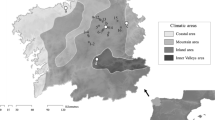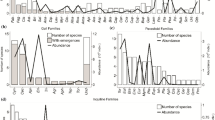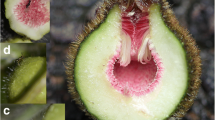Abstract
The knopper gallwasp Andricus quercuscalicis Burgsdorf 1783 (Hymenoptera: Cynipidae) has invaded western and northern Europe from southern and eastern Europe over the last 400 years. A. quercuscalicis has two alternating generations, which differ in phenology, structure, and host oak species. This study describes geographic variation in the community in the tiny catkin galls of the sexual generation on Turkey oak, Quercus cerris, and compares the patterns obtained with those in the community attacking the alternate agamic generation. As predicted from considerations of parasitoid recruitment to the communities of invading phytophagous insects (Cornell and Hawkins 1993), in its native range the sexual generation shows (1) higher parasitoid community species richness, (2) higher total mortality due to parasitoid attack and (3) a higher ratio of specialist to generalist parasitoid species than is evident in the invaded range. Counter to predictions, there is no indication that parasitoid community richness in the invaded range has increased with time since the arrival of the new host. Higher host mortality in the native range is due principally to a single specialist, Aulogymnus obscuripes Mayr 1877 (Hymenoptera: Eulophidae), and is not distributed evenly among parasitoid species which attack the gall-former only in this area. This contrasts with the community in Britain, where three principal generalist parasitoids cause approximately equal mortalities. The agamic gall contains a taxonomically and structurally diverse guild of parasitoid and inquiline species, associated with the changing resource provided by a large, long-lived, complex gall. In contrast, the sexual community includes a taxonomically and structurally narrow guild, associated with a resource which is structurally simple, small in size and short-lived. No parasitoid species attacks the gall-former in both generations. Surprisingly, in spite of these differences in the nature of the gall resource in the two generations, over their entire range (native and invaded) the parasitoid guilds of the two are equally species rich.
Similar content being viewed by others
References
Ambrus B (1974) Cynipid galls In: Fauna Hungariae, vol 12 (Hymenoptera 2, part 1/a, serial No 116) Academic Press, Budapest, Hungary
Askew RR (1961a) On the biology of the inhabitants of oak galls of Cynipidae (Hymenoptera) in Britain. Trans Soc Br Entomol 14: 237–269
Askew RR (1961b) A study of the biology of species of the genus Mesopolobus Westwood (Hymenoptera: Pteromalidae) associated with cynipid galls on oak. Trans Entomol Soc Lond 113: 237–269
Askew RR (1961c) Ormocerus latus Walker and Ormocerus vernalis Walker (Hymenoptera; Pteromalidae), parasites in cynipid oak galls. Entomologist 94: 193–195
Askew RR (1975) The organisation of chalcid-dominated parasitoid communities centred upon endophytic hosts. In: Price PW (ed) Evolutionary strategies of parasitic insects and mites. Plenum Press, New York, pp 130–153
Askew RR (1980) The diversity of insect communities in leaf mines and plant galls. Anim Ecol 49: 817–829
Askew RR (1984) The biology of gall wasps. Oxford and IBH, New Delhi, pp 223–271
Askew RR, Shaw MR (1986) Parasitoid communities: their size, structure and development. In: Waage J, Greathead DW (eds) Insect parasitoids. Academic Press, New York London, pp 225–264
Boucek Z (1965) A review of the Chalcidoid fauna of the Moldavian S.S.R., with descriptions of new species (Hymenoptera). Acta Faun Entomol Mus Natl Pragae 11: 5–38
Boucek Z (1977) A faunistic review of the Yugoslavian Chalcidoidea. Acta Entomol Yugoslaviee [Suppl] 13: 49 pp
Boucek Z, Watsham A, Weibes JT (1981) The fig wasp fauna of the receptacles of Ficus thonningii. Tijdschr Entomol 124: 149–231
Buhr H (1965) Bestimmungstabellen der Gallen (Zoo und Phytocecidien) an Pflanzen Mittel- und Nordeuropas, vol 2. Gustav Fischer, Jena, Germany, pp 763–1572
Charnov EL (1979) The genetical evolution of patterns of sexuality: Darwinian fitness. Am Nat 113: 465–480
Collins M, Crawley MJ, McGavin GC (1983) Survivorship of the sexual and agamic generations of Andricus quercuscalicis on Quercus cerris and Quercus robur. Ecol Entomol 8: 133–138
Cornell HV (1985) Local and regional richness of cynipine gall wasps on California oaks. Ecology 66: 1247–1260
Cornell HV, Hawkins BA (1993) Accumulation of native parasitoid species on introduced herbivores: a comparison of hosts as natives and hosts as invaders. Am Nat 141: 847–865
Eady RD, Quinlan J (1963) Hymenoptera, Cynipoidea. Handbooks for the identification of British insects. 8(1a). Royal Entomological Society, London
Fulmek L (1968) Parasitisekten der Insektengallen Europas. Beiträge zur Entomologie 18: 719–952
Godfray HJC, Agassiz DJL, Nash DR, Lawton JH (1995) The recruitment of parasitoid species to two invading herbivores. J Anim Ecol (in press)
Graham MWR deV (1969) The Pteromalidae of northwestern Europe (Hymenoptera: Chalcidoidea). Bull Br Mus Nat Hist [Suppl] 16: 1–851
Graham MWR deV (1987) A reclassification of the European Tetrastichinae (Hymenoptera: Eulophidae), with a revision of certain genera. Bull Br Mus Nat Hist 55: 1–392
Greathead DJ (1989) Biological control as an introduction phenomenon: a preliminary examination of programmes against Homoptera. Entomologist 108: 28–37
Hails RS (1988) The ecology of Andricus quercuscalicis and its natural enemies. PhD thesis, University of London, London
Hails RS (1989) Host size and sex allocation of parasitoids in a gall forming community. Oecologia 81: 28–32
Hails RS, Crawley MJ (1991) The population dynamics of an alien insect: Andricus quercuscalicis (Hymenoptera: Cynipidae). J Anim Ecol 60: 545–562
Hawkins BA, Goeden RD (1984) Organisation of a parasitoid community associated with a complex of palls on Atriplex in southern California. Ecol Entomol 9: 271–292
Huntley BH, Birks JB (1983) An atlas of past and present pollen maps for Europe: 0–13,000 years ago. Cambridge University Press, Cambridge, UK
Jeffries MJ, Lawton JH (1984) Enemy free space and the structure of ecological communities. Biol J Linn Soc 23: 269–286
Lampe K-H (1984) Struktur und Dynamik des Parasitenkomplexes der Binsensackträgermotte Coleophora alticolella Zeller (Lepidoptera: Coleophoridae) in Mitteleuropa. Zool Jahrb Syst Ökol Geogr Tiere 111: 449–492
Lawton JH, Strong DR (1981) Community patterns and competition in folivorous insects. Am Nat 118: 317–338
Moriya S, Inoue K, Otake A, Shiga M, Mabuchi M (1989) Decline of the chestnut gallwasp population, Dryocosmus kuriphilus Yasumatsu (Hymenoptera: Cynipidae) after the establishment of Torymus sinensis Kajimo (Hymenoptera: Torymidae). Appl Entomol Zool 24: 231–233
Nash DR, Agassiz JL, Godfray HCJ, Lawton JH (1995) The pattern of spread of invading species: two leaf-mining moths colonising Great Britain J Anim Ecol (in press)
Nieves Aldrey JL (1983) Contribución al conocimiento de los eulófidos (Hym. Chalcidoidea, Eulophidae) parásitos en las agallas de cinípidos producidas sobre especies de Quercus. Bol Asoc Esp Entomol 7: 43–54
Notton DG (1988) Parasitoids of the sexual and parthenogenetic generations of Andricus quercuscalicis (Burgsdorf 1783); Hym.: Cynipidae. Cecidology 3: 15–17
Otake A, Shiga M, Moriya S (1984) Colonisation of Torymus sinensis Kamijo (Hymenoptera: Torymidae), a parasitoid of the chestnut gallwasp, Dryocosmus kuriphilus Yasumatsu (Hymenoptera: Cynipidae) introduced from China. Appl Entomol Zool 19: 111–114
Pfützenreiter F, Weidner H (1958) Die Eichengallen im Naturschutzgebiet Favoritepark in Ludwigsburg und ihre Bewohner. Publ Landestelle Natur Lanschaft 29: 88–130
Price PW, Bouton CE, Gross P, McPherson BA, Thompson JN, Weis E (1980) Interactions among three trophic levels: influence of plants on interactions between insect herbivores and natural enemies. Annu Rev Ecol Sys 11: 41–65
Schönrogge K, Stone GN, Crawley MJ (1994) Spatial and temporal variation in guild structure: parasitoids and inquilines of Andricus quercuscalicis (Hymenoptera: Cynipidae) in its native and alien ranges. Oikos 72: 51–60
Stone GN, Sunnucks PJ (1993) The population genetics of an invasion through a patchy environment: the cynipid gallwasp Andricus quercuscalicis. Mol Ecol 2: 251–268
Strong DR, Lawton JH, Southwood TRE (1984) Insects on plants: community patterns and mechanisms. Blackwell, Oxford London
Sunnucks P, Stone GN, Schönrogge K, Csóka G (1994) The biogeography and population genetics of the invading gallwasp Andricus quercuscalicis. In: Williams M, Leach C (eds) Plant galls: organisms, interactions, populations. (Special volume) British Systematics Association, Clarendon press, Oxford, U.K., pp 351–368
Ulenberg SA (1985) The phylogeny of the genus Aprocrypta Coquerel in relation to its hosts Ceratolosen Mayr and Ficus L. Verh K Ned Akad Wetensch 83: 149–176
Washburn JO, Cornell HV (1979) Chalcid parasitoid attack on a gall wasp population on oak (Acraspis hirta Bassett, on Quercus prinus, Fagaceae). Can Entomol 111: 391–400
Washburn JO, Cornell HV (1981) Parasitoids, patches and phenology: their possible role in the local extinction of a cynipid gall wasp population. Ecology 62: 1597–1607
Weis AE (1982) Resource utilisation patterns in a community of gall-attacking parasitoids. Environ Entomol 11: 809–815
Welch RC (1993) Colonisation of introduced oaks by Cynipinae. Cecidology 8: 58–76
Wiebes-Rijks AA (1978) The sexual generation of the Andricus kollari group in the Netherlands (Hymenoptera, Cynipidae). Entomol Bericht 38: 139–142
Author information
Authors and Affiliations
Rights and permissions
About this article
Cite this article
Stone, G.N., Schönrogge, K., Crawley, M.J. et al. Geographic and between-generation variation in the parasitoid communities associated with an invading gallwasp, Andricus quercuscalicis (Hymenoptera: Cynipidae). Oecologia 104, 207–217 (1995). https://doi.org/10.1007/BF00328585
Received:
Accepted:
Issue Date:
DOI: https://doi.org/10.1007/BF00328585




